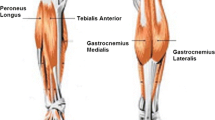Abstract
Dynamics of human wrist play an important role in human-robot interaction. In this paper, we develop a novel method to classify the human wrist’s motion and to recognize its stiffness profile. In the proposed method, an integrated framework of linear discriminant analysis and extreme learning machine is developed to evaluate the intention of the wrist. Specifically, linear discriminant analysis is used to classify gestures of the wrist. Based on the result of classification, extreme learning method is use to construct a regression model of the stiffness. The experimental results are demonstrated the effectiveness of the proposed method.
Access this chapter
Tax calculation will be finalised at checkout
Purchases are for personal use only
Similar content being viewed by others
References
Hang, S., et al.: Improved human-robot collaborative control of redundant robot for teleoperated minimally invasive surgery. IEEE Robot. Autom. Lett. 4(2), 1447–1453 (2019)
Hang, S., Sandoval, J., Makhdoomi, M., et al.: Safety-enhanced human-robot interaction control of redundant robot for teleoperated minimally invasive surgery. In: 2018 IEEE International Conference on Robotics and Automation (ICRA), pp. 6611–6616. IEEE (2018)
Luo, J., et al.: Enhanced teleoperation performance using hybrid control and virtual fixture. Int. J. Syst. Sci. 50(3), 451–462 (2019)
Luo, J., et al.: A task learning mechanism for the telerobots. Int. J. Humanoid Robot. 16(2), 1950009 (2019)
Geethanjali, P., Ray, K.: A low-cost real-time research platform for EMG pattern recognition-based p°rosthetic hand. IEEE/ASME Trans. Mechatron. 20(4), 1948–1955 (2015)
Jahromi, M.G., Parsaei, H., Zamani, A., Stashuk, D.W.: Cross comparison of motor unit potential features used in EMG signal decomposition. IEEE Trans. Neural Syst. Rehabil. Eng. 26(5), 1017–1025 (2018)
Ryu, J., Lee, B.-H., Kim, D.-H.: sEMG signal-based lower limb human motion detection using a top and slope feature extraction algorithm. IEEE Signal Process. Lett. 24(7), 929–932 (2017)
Doulah, A.S.U., Fattah, S.A., Zhu, W.-P., Ahmad, M.O., et al.: Wavelet domain feature extraction scheme based on dominant motor unit action potential of EMG signal for neuromuscular disease classification. IEEE Trans. Biomed. Circuits Syst. 8(2), 155–164 (2014)
Ajoudani, A., Tsagarakis, N., Bicchi, A.: Tele-impedance: teleoperation with impedance regulation using a body–machine interface. Int. J. Robot. Res. 31(13), 1642–1656 (2012)
Kiguchi, K., Hayashi, Y.: An EMG-based control for an upper-limb power-assist exoskeleton robot. IEEE Trans. Syst., Man, Cybern. Part B (Cybernetics) 42(4), 1064–1071 (2012)
Han, J., Ding, Q., Xiong, A., Zhao, X.: A state-space EMG model for the estimation of continuous joint movements. IEEE Trans. Ind. Electron. 62(7), 4267–4275 (2015)
Tang, Z., Yu, H., Cang, S.: Impact of load variation on joint angle estimation from surface EMG signals. IEEE Trans. Neural Syst. Rehabil. Eng. 24(12), 1342–1350 (2016)
Yang, C., et al.: Haptics electromyography perception and learning enhanced intelligence for teleoperated robot. IEEE Trans. Autom. Sci. Eng. 99, 1–10 (2018)
Jing, P., Heisterkamp, D.R., Dai, H.K.: LDA/SVM driven nearest neighbor classification. IEEE Trans. Neural Netw. 14(4), 940–942 (2003)
Huang, G.B., Zhou, H., Ding, X., Zhang, R.: Extreme learning machine for regression and multiclass classification. IEEE Trans. Syst. Man Cybern. B Cybern. 42(2), 513–529 (2012)
Funding
This work was partially supported by National Nature Science Foundation (NSFC) under Grants 61861136009 and 61811530281 Engineering and Physical Sciences Research Council (EPSRC) under Grant EP/S001913.
Author information
Authors and Affiliations
Corresponding author
Editor information
Editors and Affiliations
Rights and permissions
Copyright information
© 2020 Springer Nature Switzerland AG
About this paper
Cite this paper
Luo, J., Liu, C., Wang, N., Yang, C. (2020). A Method of Intention Estimation for Human-Robot Interaction. In: Ju, Z., Yang, L., Yang, C., Gegov, A., Zhou, D. (eds) Advances in Computational Intelligence Systems. UKCI 2019. Advances in Intelligent Systems and Computing, vol 1043. Springer, Cham. https://doi.org/10.1007/978-3-030-29933-0_6
Download citation
DOI: https://doi.org/10.1007/978-3-030-29933-0_6
Published:
Publisher Name: Springer, Cham
Print ISBN: 978-3-030-29932-3
Online ISBN: 978-3-030-29933-0
eBook Packages: Intelligent Technologies and RoboticsIntelligent Technologies and Robotics (R0)




